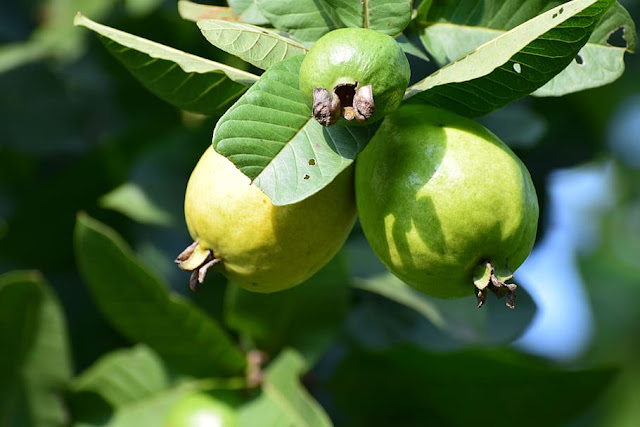Cultivation of Guava: An Important fruit crop for its nutritional content, economic benefits, and adaptability to varied conditions.
Guava (Psidium guajava L.) is one of the important commercial fruits grown in our country. It is a very popular and hardy fruit.
Nutritive Value of Guava ;
The nutritional value of the guava fruit in a 100-gram edible portion is as follows:
| Content | Quantity | % Daily Value |
|
Calories |
68 Kl | |
|
Total Fat |
1 g | 1% |
|
Saturated Fat |
0.3 g | 1% |
|
Trans Fat 0ggrams |
||
|
Polyunsaturated Fat |
.04 g | |
|
Monounsaturated |
.01 g | |
|
Cholesterol |
0 mg | |
|
Sodium |
2 mg | 0% |
|
Total Carbohydrates |
14 g | 5% |
|
Dietary Fiber |
5.4 g | 19% |
|
Sugars |
8.9 g | |
|
Protein |
2.6 g | |
| Vitamin C. | 228 mg | |
|
Calcium |
18 mg | 1% |
|
Iron |
0.3 mg | 1% |
|
Potassium |
417 mg | 9% |
|
The % Daily Value (DV) tells you how much a nutrient in a serving of food contributes to a daily diet. 2000 calories a day is used for general nutrition advice. |
||
Requirement of Climatic Conditions for Guava Cultivation ;
1) Tropical and subtropical conditions are suitable for guava cultivation.
2) The favorable temperature for guava cultivation is 15 to 30 degrees Celsius.
Soil Requirement for Guava Cultivation ;
1) Guava cultivation can be done under different types of soils.
2) The pH range between 6 to 7.5 is more suitable for its cultivation.
Selection of Guava varieties ;
|
STATE |
VARIETIES |
|
Andhra Pradesh |
Allahabad safeda, Lucknow 49, Anakapalli, Banarasi, Chittidar, Hafshi, Sardar, Smooth Green, Safed Jam, Arka Mridula |
|
Madhya Pradesh |
L-49, Allahabad safeda, Gwalior-27, Hafshi, Seedless Chittidar |
|
Jharkhand |
L-49, Allahabad safeda |
|
Karnataka |
Allahabad Safeda, L-49, Araka Mridula, Araka Amulya, Bangalore, Dharwar |
|
Assam |
Am Sophri, Madhuri Am, Safrior Payere |
|
Bihar & Jharkhand |
Allahabad Safeda, Apple Colour, Chittidar, Hafshi, Harijha, Sardar, Selection-8 |
|
Maharashtra & Gujrat |
Nagpur seedless, Dharwar, Dholka, Kothrud, L-24, L-49, Nasik, Sindh |
|
North-Eastern States |
Allahabad Safeda, Sardar, Red Fleshed. |
|
Tamil Nadu |
Anakapalli, Banarasi, Bangalore, Chittidar, Hafshi, Nagpur Seedless, Smooth Green |
|
Uttar Pradesh |
L-49, Allahabad Safeda, Lucknow Safeda, Apple Colour, Chittidar, Red Fleshed, Allahabad Surkha, Sardar, Mirzapuri Seedless, CISH-G-1, CISH-G-2, CISH-G-3 |
|
Weast Bengal |
L-49, Allahabad Safeda, Dudhe Khaja, Gole Khaja, Kabli, Baruipur, Chittidar, Harijha, Sardar |
Propagation of Guava ;
Guava Planting ;
Irrigation in Guava Orchard ;
1) The amount of irrigation given to guava fields depends upon the prevailing climatic conditions and types of soil
Manuring in Guava;
Pruning in Guava Orchard ;
Flowering and Fruiting in Guava;
Disease Management in Guava ;
a) Anthracnose: (Gloeosporium psidii );
The major symptom of this disease is Sunken, dark brown to black-colored lesions that appear on mature fruits, which may be covered in pinkish spores. The lesions may coalesce to form large necrotic patches on the surface of the guava fruit
This disease mostly occurs in moist, warm weather, which is further spread by a slash of water
Control: Spraying of guava trees with a Bordeaux mixture 0.6 % / Copper oxychloride 0.2% well before the onset of monsoon may reduce the chances of the disease incidence.
b) Pseudocercospora Leaf Spot (Pseudocercospora psidii)
This disease can occur on leaves, stems and Fruits of the Guava tree. Symptoms of this disease are small circular and subcircular dark brown lesions that appear on the plant surface with diffuse borders.
Control: Spraying copper oxychloride at 0.3 percent can reduce the infection.
This is a serious disease of guava trees. Guava wilt is sometimes encountered, especially in alkaline soils. The symptoms of guava wilting can be easily visualized by browning and wilting of the leaves, discoloration of the stem, and later on, the death of the branches along one side. Eventually, the infection girdles the entire stem, and the whole plant may wilt. In some of the severe cases, the whole tree may die.
Control: wilt infection can be controlled by soil drenching with Brasicol and spraying of Bavistin (0.1%) around the roots and leaves at an interval of 15 days.
